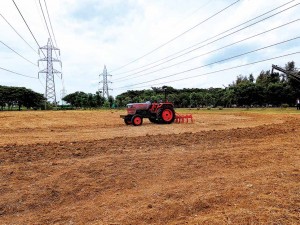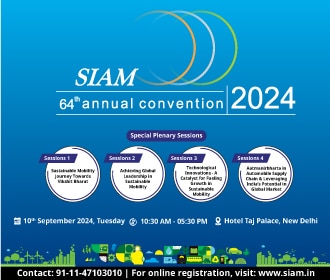Mahindra has showcased driverless technology in the form of an autonomous tractor.
Story & Photos:
Bhargav TS
To make farming productive and profitable, Mahindra & Mahindra (M&M) has unveiled an autonomous tractor. Showcasing driverless technology, the autonomous tractor, developed at the Mahindra Research Valley, the Group’s innovation and technology hub in Chennai, is claimed to reduce health hazards for farmers. Expected to change the future of food production, the tractor is programmed to carry out specific tasks. Operable remotely, it is slated for a commercial launch in early 2018.
To be launched in a phased manner, the tractor is connected to Mahindra’s ‘DiGiSENSE’ technology. To be launched in a phased manner, it will be also launched in three phases of technology – with driver in the driving seat, in quasi-driverless mode, and in the driverless mode. In the first phase, the driver, despite being in his seat will not operate the tractor. The tractor will auto steer, auto headland turn, skip passing and auto implement lift. In the second level technological phase, the driver will continue to be in the seat. He will however not need to do anything as the tractor will move on a pre-programmed path. Geo-fenced, and with an ability to detect an obstacle, the tractor features brake by wire. The third phase will include an operator without the driver. The tractor will be remotely guided. It will have automated route planning, obstacle avoidance, drive by wire and shift by wire. Plans are underway to offer autonomous tractor technology in the 20 hp to 100 hp range. Speaking at the unveiling ceremony of the autonomous tractor, Dr. Pawan Goenka, Managing Director, M&M, expressed that the (driverless) tractor technology opens up new possibilities in farming. “It is not as much about the cost of ownership as it is about the reduction in the drudgery of farming. Our tractor R&D has always been at the forefront of pioneering cutting-edge solutions. The driverless tractor opens up new possibilities in farming. We are happy to dedicate this innovative mechanisation to the global farming community, in line with our Farming 3.0 proposition.”
The Farming 3.0 proposition is about the use of technology and innovation in farming. It is aimed at bringing greater professionalism within the farming ecosystem, and is engineered to help conserve the environment and turn out high quality farm produce. Incorporating high tech sensors, cloud computing, and specialised systems, the Framing 3.0 proposition has the autonomous tractor as a key element, which will make a smart farming machinery and support precise agricultural practices, digital platforms, custom hiring and fitter ecosystem. Featuring auto transmission (shift by wire), auto throttle (driver by wire), obstacle detection (brake by wire) and tractor master controller, the autonomous tractor employing other technology elements. The highlight is the scalability. The autonomous tractor could be scaled across the horse power range, across applications, and in terms of adaptability, programming and control. The tractor could be controlled by a tablet or a mobile phone.
Equipped with unique safety features such as geofence lock, which prevents it from going outside the predefined boundaries of the farm, the autonomous tractor could be controlled via a tablet interface, which enables the farmer to programme various inputs to enhance efficiency. A farmer can thus control the tractor remotely via a tablet. He or she can remotely start or stop the engine especially in the case of an emergency. The technology of an autonomous tractor will be deployed across Nuvo, Jivo and Yuvo according to Goenka. Claimed Aravind S Bharadwaj, CTO, M&M, that the technology will be deployed in the international markets as well. There, it is expected to provide Mahindra tractors with a distinct competitive advantage. Averred Goenka, “Our target is to price the autonomous tractor at less than Rs 100,000 a unit. We are working on reducing the costs to meet that target. Getting the costs right, and regulatory approval are two challenges that we will face. India, as of date, does not have any regulation for driverless vehicles. We are therefore discussing with regulatory authorities and are hopeful that we will get the necessary approvals in time. We want to launch the tractor in the fourth quarter of FY2017-18.” Hoping that the government will draw a framework, and execute policy changes to enable the company to launch the innovative technology in India, Mahindra, said Goenka, is not seeing any regulatory hurdle for the first two phases.” Working with union agriculture ministry to see how the technology and innovation can be forwarded, the company, according to Goenka, will empower the farmer to work in his field for longer hours. “He (the farmer) will not need to expose himself to the harsh weather. He will not have to work under difficult operating conditions. He can protect himself from potential health hazards resulting in operations like insecticide spraying. The same can now be done without human intervention,” explained Goenka. He opined that consistency in farming will lead to higher productivity and better quality.






























